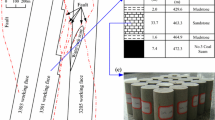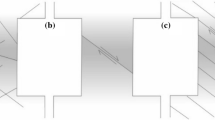Summary
Laboratory and In Situ Mechanical Behavior Studies of Fractured Oil Shale Pillars
Preliminary results are reported of a cooperative research agreement between the U. S. Bureau of Mines and the Colony Development Operation of the Atlantic Richfield Corporation. The overall objective of this program is to correlate laboratory and in situ behavior of fractured oil shale pillars and to use this information to develop design criteria for underground room-and-pillar mining of oil shale.
In situ stress measurements in the Colony mine have been made in pillars of oil shale containing joints of which the planes of weakness are oriented at low angles (<45°) to the pillar axis. Four findings of importance have resulted from these measurements. 1) Some pillars are in a post-failure condition, that is, an increase in deformation in the pillars results in a decrease in the load the pillars can sustain; 2) Pillar failure begins when the maximum and minimum stresses within the pillar become approximately 5,000 psi and 800 psi, respectively; 3) In situ measurements suggest that the stresses carried by the “solid” portion of a pillar become constant when the fractured pillar is in a post-failure condition; 4) Severely fractured pillars in a post-failure condition can be stabilized, that is, further fracturing can be prevented, by the addition of small radical confinement such as provided by rock bolting normal to the major joint pattern in the pillar. The latter three observations are predicted from laboratory studies on model pillars of oil shale containing joints oriented with respect to the applied stress field as its in situ counterpart. The application of these results and problems associated with applying them to design room-and-pillar mining in oil shale is discussed.
Zusammenfassung
Laboratorium- und In-situ-Studien über das mechanische Verhalten von brüchigen Ölschiefer-Pfeilern
In dem vorliegenden Bericht werden die Ergebnisse des Forschungsvertrages zwischen dem U. S. Bureau of Mines und dem Colony Entwicklungs-unternehmen der Atlantic Richfield Gesellschaft vorgelegt. Das Ziel dieses Programmes ist die Erfassung der Beziehung zwischen Laboratoriums- und In-situ-Unter-suchungen über das Verhalten von brüchigen Ölschiefer-Pfeilern und die Anwendung der Ergebnisse für die Entwicklung von Entwurfskriterien für den Untertagebergbau mit der Raum- und Pfeiler-Methode. Die In-situ-Messungen in der Colony-Grube wurden an Ölschiefer-Pfeilern, deren Trennflächen mit der Pfeilerachse einen kleinen Winkel einschließen, durchgeführt. Vier wichtige Ergebnisse wurden durch diese Messungen festgestellt. 1. Etliche Pfeiler befinden sich im „post-failure-Zustand“, das heißt, eine Zunahme der Deformation ergibt eine Abnahme der Tragfähigkeit der Pfeiler. 2. Das Versagen der Pfeiler erfolgt, wenn die maximale und minimale Druckspannung in den Pfeilern ungefähr 5000 psi und 800 psi erreicht. 3. Die In-situ-Messungen ergeben, daß die Last, die vom unbeschädigten Teil des Pfeilers getragen wird, konstant bleibt, wenn brüchige Pfeiler sich im Post-failure-Zustand befinden. 4. Stark brüchige Pfeiler im Post-failure-Zustand können stabilisiert werden, d. h. weiterer Abbruch kann durch Felsankerung normal zu den Trennflächen vermieden werden. Die letzten drei Beobachtungen wurden im Laboratorium anhand von Modellpfeilern aus Ölschiefer gemacht, die Trennflächen enthalten, die, abgestimmt auf das angewendete Kraftfeld, dermaßen orientiert sind, daß die Ergebnisse mit den In-situ-Messungen vergleichbar werden. Die Anwendung dieser Ergebnisse für die Praxis im Untertagebau mit Hilfe der Raum-Pfeiler-Methode für Ölschiefer werden besprochen.
Résumé
Etude en laboratoire et in situ concernant le comportement mécanique des piliers pétrolifères schisteux fracturés
Dans le rapport on présente des résultats des travaux de recherche effectués en commun entre le US Bureau of Mines et le Colony Development Operation of the Atlantic Richfield Corp. Le but de ce programme fut de déterminer oue relation entre des essais effectués en laboratoire et ceux in situ concernant le comportement des piliers pétrolifères schisteux fracturés et l'application de ces resultats dans la technique de creusement de cavité par piliers. Les essais in situ effectués dans les Mines de Colony ont été faites sur des piliers schisteux pétrolifères dont les joints de séparation forment un petit angle avec l'axe du pilier. Lors de ces mesures quatre résultats importants ont été trouvès. 1) Plusieurs de ces piliers ont été dans un état “après rupture”; de ce fait une augmentation de la déformation diminue la charge qui peut supporter le pilier. 2) La rupture du pilier commence quand les contraintes maxima et minima dans le pilier atteignent 5.000 psi et 800 psi, resp. 3) Quand les piliers fracturés se trouvent dans un état après préliminaire, les mesures effecuté in situ montrent que la charge portée par la partie non fracturée du pilier reste constante. 4) Des piliers fortements fracturés dans un état après préliminaire peuvent être stabilisés, c'est à dire une fracture progressive peut être empechée, à l'aide des ancrages orientées perpendiculèrement aux joints de séparation.
Les trois dernieres observations ont été faites en laboratoire à l'aide des piliers modèls en pétrolifères qui contiennent des joints de séparation; ces derniers ont été situ. D'autre part on discute l'application des résultats présentés pour la conception de travaux d'excavation par piliers dans des roches pétrolifères.
Similar content being viewed by others
References
Agapito, J. F. T.: “Pillar Design in Competent Bedded Formation”, Ph. D. Thesis, Colorado School of Mines, 1965 pp., Golden, Colo., 1972.
Brady, B. T., W. I. Duvall, and F. G. Horino: “Experimental Determination of the True Uniaxial Stress-Strain Behavior of Brittle Rock”, Rock Mechanics, Vol. 5, pp. 107–120, 1973.
Brady, B. T., and W. I. Duvall: “Strengthening of Fractured Rock Pillars by the Use of Small Radial Reinforcement Pressure”, U. S. BuMines, Rept. of Investigations, 7755, 1973.
Horino, F. G., and V. E. Hooker: “The Mechanical Properties of Oil Shale and In Situ Stress Determinations, Colony Mine”, BuMines Progress Report DMRC 10001, 17 pp. Dec. 1971.
Horino, F. G., B. T. Brady, W. I. Duvall, and V. E. Hooker: “A Thousand-Ton Capacity Stiff-Testing Machine”, BuMines R. I. 7624, 19 pp., 1972.
Merrill, R. H.: “Three-Component Borehole Deformation Gage for Determining the Stress in Rock”, BuMines R. I. 7015, 38 pp., 1967.
Obert, L., and W. I. Duvall: “Rock Mechanics and the Design of Structures in Rock”, 650 pp., John Wiley and Sons, Inc., New York, 1967.
Starfield, A. M., and W. R. Wawersik: “Pillars as Structural Components in Room-and-Pillar Design”, Proceedings of Tenth Rock Mechanics Symposium, Basic and Applied Rock Mechanics, pp. 793–809, AIME, 1968.
Author information
Authors and Affiliations
Additional information
With 12 Figures
Rights and permissions
About this article
Cite this article
Brady, B.T., Hooker, V.E. & Agapito, J.F.T. Laboratory and in situ mechanical behavior studies of fractured oil shale pillars. Rock Mechanics 7, 101–120 (1975). https://doi.org/10.1007/BF01351904
Received:
Issue Date:
DOI: https://doi.org/10.1007/BF01351904




